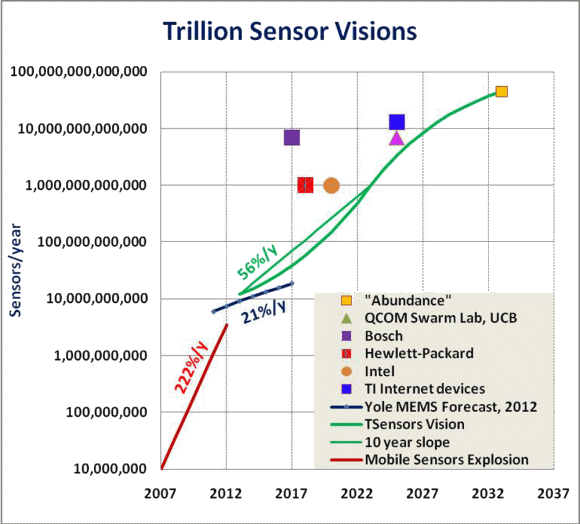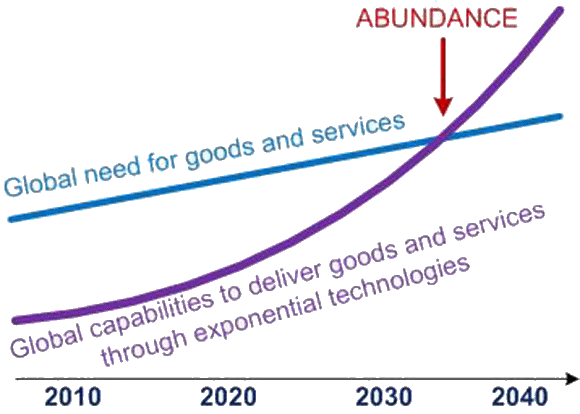
Introduction
Technology can lead to exponential growth in products and services as exemplified by the billions of cellphones now in existence and the observation that today, one is more likely to find a cell phone signal than clean drinking water on planet earth! The prediction is now forming wherein trillions of sensors will be distributed throughout society because our society demands infinitely more information about everything around us, from our environment, to our bodies, to the condition of our homes and public and private assets.
Further, a condition called "Abundance" is now predicted and a Best-Selling Book by this title illustrates how technology will lead to a world wherein everyone has all their basic human needs satisfied, i.e., sufficient water, food, energy, healthcare, education, and freedom. For this to approach fruition, trillions of sensors will be needed to satisfy the "awareness" demanded by this situation. A broad group of visionaries in the sensor community have produced a roadmap of the drive to trillions of sensors and the consequences thereof and a meeting for this purpose was held in October 2014 at Stanford University.

Fig. 1: Thanks to the mobile-device market, there exists a $3.5-billion sensor market.
Looking at figure 1 (red line at right), there is now a 3.5 billion sensor market due to the explosion of mobile devices. It is clear that mobile devices have put billions of physical sensors in place that include temperature, pressure, acceleration, light, and proximity in consumer, medical, automotive, and industrial products.
Devices used for the benefit of consumers and by societal infrastructure have created high volume markets for sensors. And the prediction is that systems supporting global evolution and solutions to global problems like the elimination of hunger, a supply of abundant clean water and air, the reduction of global warming, the development of green energy, and the provision of universal healthcare at an affordable price will drive the need to trillions of sensors.
Chemical Sensors
Where do Chemical Sensors fit in our march to trillions of sensors? I cannot imagine reaching any of these goals without being able to sense energy gases, pollutants in air and water, and medical conditions that are comprised of chemical and biochemical compounds. Furthermore, there is a significant societal trend and demand for sensors that can provide humans with information about their health and their environment, and consumers demand that this information comes from sensors integrated into devices that are seamless parts of their lives, like cell phones, watches, and clothing.
Gas sensors provide key information about air quality, health threats and dangerous conditions, energy efficiency, and they can even analyze your breath to spot diseases or analyze your body's performance. Having looked at the need for trillions of sensors, how does the chemical sensor community produce these sensors, which will need to be low cost and high volume as well as high performance?
History tells us that typical sensor developments can take 20 years or more from sensor invention to product introduction. Also, the sensors that are needed for health, wellness, and situation awareness must be capable of sensing emergent properties and provide information as opposed to data signals. The chemical-/bio-sensor technology needed by the 2030 prediction of Abundance that provide for human needs will be designed for sensory capability, integration into devices, and manufacturability (see figure 2). The diversity encountered in chemical dimensions adds immensely to the challenge of producing sensors compensated for rapidly changing temporal, spatial, and environmental situations in complex chemical and biochemical situations.

Fig. 2: According to abundance theory, the global need for sensors and the ability to produce them occurs around 2030.
Large markets will obviously come from the emerging global tides such as Abundance, CeNSE, Internet of Things, Digital Health, Context Computing, IBM 5-in-5 senses for computers, and the like and all of these will require large numbers of chemical domain sensors, from simple variables such as water and air pollution to complex ones such as body fluid diagnosis, health status, or toxicity.
Chemical sensors have already reached mobile markets, including humidity sensors embedded into the Samsung S4 cellphones and organicity embedded in "appcessories". Clearly the challenge to create high volume chemical sensors is here.
Adapting
Several emerging manufacturing technologies are available that can transition chemical sensors into the trillion sensor universe. We report here on the major challenges and opportunities to get to trillions of chemical sensors in everyday life.
The examples of "printed" and MEMS sensors are unique not only for their improved performance but also for the low cost manufacturing approach. These sensors allow integration of high volumes of chemical sensors with the exponential technologies that include biotechnology and bioinformatics, computational systems, networks of sensors, artificial intelligence, robotics, digital manufacturing, infinite computing, medicine, and nanomaterials and nanotechnology.
How we develop and apply chemical sensors will strongly influence the world in which we live and chemical/bio sensors must be one of the enabling technological innovations.
About the Authors
Dr. Joseph R. Stetter is the President of KWJ Engineering Inc. He obtained a Ph.D. in Physical Chemistry from the University at Buffalo (SUNY) in 1975. In the 1970s, Dr. Stetter was Director of Chemical Research at the Energetics Sciences Division of Becton Dickinson and Company. While at the Argonne National Laboratory in Chicago, IL in the '80s, he led the development of the first integrated and operational "sensor-array-based" instrument with pattern recognition, now called electronic nose.
Edward F. Stetter is the CFO of KWJ Engineering Inc. He has a B.B.A. in Marketing and a B.S. in Computer Applications from the University of Notre Dame, and a J.D. from the Illinois Institute of Technology: Chicago-Kent College of Law. Ed was previously the President of Transducer Technology, Inc., prior to its merger with KWJ Engineering Inc. in January 2007.
Related Stories
Sandia showcases biology breakthroughs available for licensing
Indoor Air Quality: A Sleeping Giant That Sensors Will Awaken
Global Smart Waste Market Growing at 16% CAGR to 2019
Sandia Labs anthrax detector takes home national technology transfer award